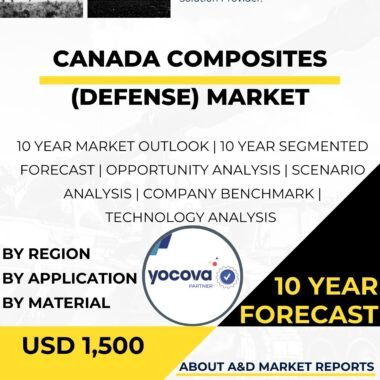Description
The composites market in Sweden’s defense industry is a crucial sector that plays a significant role in enhancing the country’s military capabilities and supporting its defense modernization efforts. Composites are advanced materials composed of two or more distinct components, typically a matrix and reinforcement fibers, which combine to create lightweight, strong, and durable structures. As a nation with a strong commitment to technological innovation and a thriving defense industry, Sweden actively invests in indigenous composite technologies to ensure self-sufficiency, reduce the weight and improve the performance of its defense equipment, and address emerging security challenges.
The use of composites in the defense sector has revolutionized the design and manufacturing of various military platforms, including aircraft, naval vessels, armored vehicles, and munitions. The composites market in Sweden encompasses a diverse range of applications, from advanced composite materials for structural components to composite-based armor solutions for enhanced protection against ballistic and explosive threats.
The development and integration of advanced composite materials have been instrumental in improving the operational capabilities of the Swedish Armed Forces. By replacing traditional metal structures with composites, defense equipment becomes significantly lighter without compromising on strength and durability. This weight reduction translates to increased payload capacity, extended range, and improved fuel efficiency for military platforms, such as fighter jets, helicopters, and unmanned aerial vehicles (UAVs), enhancing their combat effectiveness and operational range.
Moreover, composites offer inherent resistance to corrosion, which is particularly advantageous for naval vessels operating in corrosive maritime environments. By utilizing composite materials in the construction of ships and submarines, the Swedish Navy benefits from increased longevity and reduced maintenance requirements, resulting in lower life-cycle costs and enhanced fleet readiness.
In the area of armored vehicles, composites play a crucial role in providing enhanced protection for military personnel against ballistic threats and explosions. Composite armor solutions offer higher strength-to-weight ratios compared to traditional steel armor, enabling the development of lighter and more maneuverable vehicles without compromising on crew safety. This advantage is especially valuable in modern asymmetric warfare scenarios, where agility and adaptability are critical for survivability.
Saab Group, a leading defense contractor in Sweden, has been at the forefront of developing and integrating advanced composites in defense applications. Saab’s expertise in composite materials, manufacturing processes, and structural design has made it a key contributor to Sweden’s indigenous composite capabilities. Saab’s flagship products, such as the Gripen E/F fighter jet and the Visby-class corvettes, incorporate advanced composites to improve performance and maintain a competitive edge in the global defense market.
Sweden’s investment in indigenous composite technologies not only enhances its defense capabilities but also contributes to technological advancements and economic growth. The development of cutting-edge composite materials requires significant research and development efforts, which stimulate the growth of the domestic defense industry and foster collaboration between academia and private enterprises. As the defense sector benefits from advancements in composites, these materials find applications in other industries, such as aerospace, automotive, and renewable energy, further contributing to the nation’s economic diversification and innovation.
The composites market in Sweden also supports the country’s export-oriented defense industry. Swedish defense companies leverage their expertise in composites to provide cutting-edge solutions to international customers seeking to enhance the performance and capabilities of their own military equipment. Exporting composites-based defense solutions not only boosts Sweden’s economic growth but also strengthens defense partnerships with friendly nations and supports international security and stability efforts.
As security threats continue to evolve, Sweden’s defense industry remains committed to advancing its composite technologies. Research and development efforts focus on enhancing the mechanical properties of composites, exploring new manufacturing techniques, and developing innovative applications for these materials. Additionally, the drive for sustainable and environmentally friendly solutions influences the development of composites using recycled or bio-based materials, contributing to Sweden’s commitment to sustainability and responsible resource management.
Despite its strengths, the composites market in Sweden faces challenges that warrant careful consideration. One primary consideration is the need to balance the costs and benefits of utilizing advanced composites in defense applications. While composites offer significant advantages in terms of weight reduction and performance enhancement, their production can be more expensive than traditional materials. Therefore, a thorough cost-benefit analysis is essential to determine the most appropriate applications for composites in defense equipment.
Moreover, ensuring the reliability and durability of composite structures over their operational lifetimes is a critical aspect of composite technology development. Extensive testing, quality control measures, and continuous monitoring are necessary to ensure that composites meet rigorous defense standards and remain operational under challenging conditions.
In conclusion, the composites market in Sweden’s defense industry is a crucial component of the country’s defense modernization efforts, providing lightweight, strong, and durable materials to enhance the performance of military equipment. Sweden’s investment in indigenous composite technologies ensures self-sufficiency, promotes technological advancements, and supports economic growth. Advanced composite materials are instrumental in improving the operational capabilities of the Swedish Armed Forces, from fighter jets and naval vessels to armored vehicles and munitions. By addressing challenges proactively and investing in research and development, Sweden is well-positioned to maintain a competitive edge in the global composites market, supporting its defense needs and contributing to international peacekeeping and security efforts.




